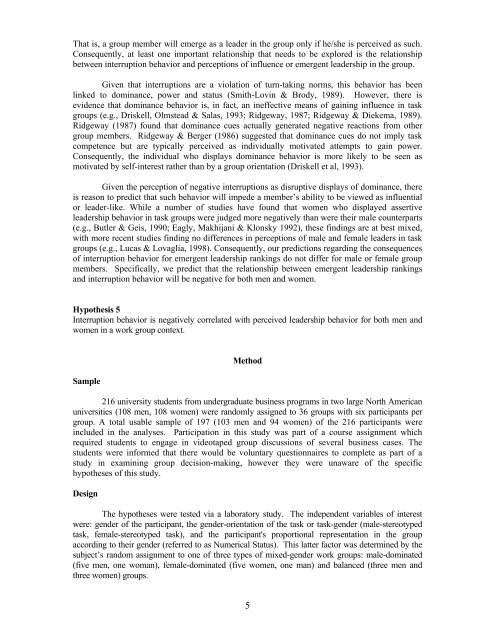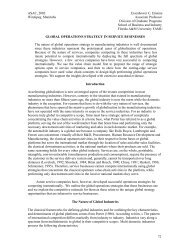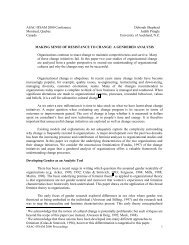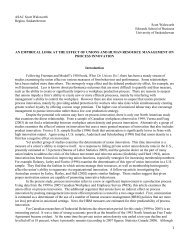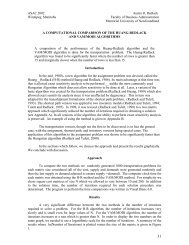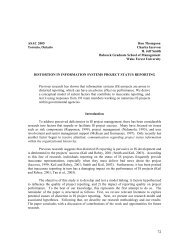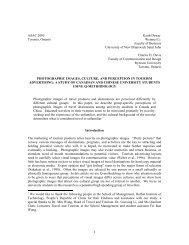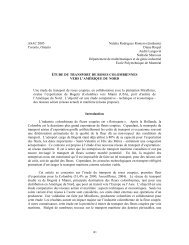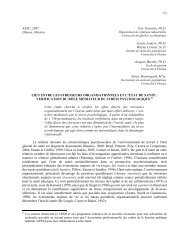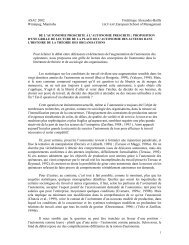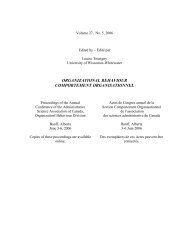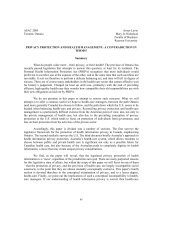on expectations and behaviour (Berger et al, 1980). For example, individuals expect others toperform better at tasks that are appropriate or compatible with their gender (e.g., Karakowsky &McBey, 2001). This has important implications for behavior in mixed-gender groups, since itsuggests that perceptions of relative status or expertise can arise as a consequence of gender-biasedtasks and specifically of perceptions of congruence or incongruence with the perceived genderorientationof the group’s task.Numerous scholars have suggested that through experience, individuals come to sharebeliefs about the extent to which tasks are linked to gender (e.g., Piliavin & Martin, 1978; Wood &Karten, 1986). Masculine- and feminine-typed jobs are not necessarily equally distributed at worklargely because professional, managerial and many technical jobs have been dominated for longperiods of time by men and thus continue to be perceived as masculine despite recent increases in theentry of women (Vancouver & Ilgen, 1989). In team contexts, when a team member’s gender isincongruent with the perceived gender-orientation of the team’s task, that team member will be lesslikely to engage in power displays. Incongruent gender-biased tasks can trigger perceptions ofbeing “out of one’s territory” and consequently can reduce the tendency to display power orinfluence (e.g., Dovidio, Brown, Heltman, Ellyson & Keating, 1988). While both men and womenare affected by congruence or incongruence with the perceived gender-orientation of the task,previous research suggests that men are more resistant to changes in task-based cues, and will beless affected by incongruence with the task’s gender-orientation (Lenney, 1977; Vancouver &Ilgen, 1989). In addition, men tend to adhere more strongly to traditional gender role beliefs (e.g.,Spence & Hahn, 1997; Twenge, 1997) and experience greater cultural pressure to conform tosuch beliefs (Herek, 1986) compared to women. For women, diffuse status cues and socializedgender roles create a greater burden and consequently are more likely to be negatively affected byincongruence with the gender-orientation of the task (Berger et al, 1980). For example, a numberof studies have shown that found that women's self-confidence tends to vary as a function ofperceived gender-orientation of the task, while men's self-confidence remains relatively stable acrosstasks (e.g., Carr, Thomas & Mednick, 1985).In line with the assertions outlined above, we predict that the decrease in interruptionbehavior among individuals, as they move from male-dominated to female-dominated groups,will be greatest among women performing gender-incongruent tasks (the male-stereotyped task).In other words, in addition to the inhibiting influence of female-dominated groups on powerdisplays, gender-incongruent tasks will act as a further impediment. And, according to theresearch cited above, this effect will be greater for women than for men.Hypothesis 4Incongruence with the gender-orientation of the group’s task will result in greater decrements ininterruption behavior for women compared to men, as they move from male-dominated tofemale-dominated work groups.An obvious question that arises from our examination above is – what are theconsequences of interruption behavior for group members? While the literature has viewedinterruption behavior as a reflection of power or status, it is also important to consider whethersuch power displays ultimately enhance a member’s status in the group. Consequently, anadditional aim of this study was to examine whether interruption behavior has any impact onperceived status in a group – does such behavior reinforce status perceptions? One way to addressthis question is to consider whether group members who engage in higher rates of interruptionbehavior are more likely to be viewed as exerting greater influence or leadership in the group.Goktepe & Schneier (1989) defined emergent leaders as members who lack formalauthority over other members but nonetheless exert significant influence over other members.4
That is, a group member will emerge as a leader in the group only if he/she is perceived as such.Consequently, at least one important relationship that needs to be explored is the relationshipbetween interruption behavior and perceptions of influence or emergent leadership in the group.Given that interruptions are a violation of turn-taking norms, this behavior has beenlinked to dominance, power and status (Smith-Lovin & Brody, 1989). However, there isevidence that dominance behavior is, in fact, an ineffective means of gaining influence in taskgroups (e.g., Driskell, Olmstead & Salas, 1993; Ridgeway, 1987; Ridgeway & Diekema, 1989).Ridgeway (1987) found that dominance cues actually generated negative reactions from othergroup members. Ridgeway & Berger (1986) suggested that dominance cues do not imply taskcompetence but are typically perceived as individually motivated attempts to gain power.Consequently, the individual who displays dominance behavior is more likely to be seen asmotivated by self-interest rather than by a group orientation (Driskell et al, 1993).Given the perception of negative interruptions as disruptive displays of dominance, thereis reason to predict that such behavior will impede a member’s ability to be viewed as influentialor leader-like. While a number of studies have found that women who displayed assertiveleadership behavior in task groups were judged more negatively than were their male counterparts(e.g., Butler & Geis, 1990; Eagly, Makhijani & Klonsky 1992), these findings are at best mixed,with more recent studies finding no differences in perceptions of male and female leaders in taskgroups (e.g., Lucas & Lovaglia, 1998). Consequently, our predictions regarding the consequencesof interruption behavior for emergent leadership rankings do not differ for male or female groupmembers. Specifically, we predict that the relationship between emergent leadership rankingsand interruption behavior will be negative for both men and women.Hypothesis 5Interruption behavior is negatively correlated with perceived leadership behavior for both men andwomen in a work group context.SampleMethod216 university students from undergraduate business programs in two large North Americanuniversities (108 men, 108 women) were randomly assigned to 36 groups with six participants pergroup. A total usable sample of 197 (103 men and 94 women) of the 216 participants wereincluded in the analyses. Participation in this study was part of a course assignment whichrequired students to engage in videotaped group discussions of several business cases. Thestudents were informed that there would be voluntary questionnaires to complete as part of astudy in examining group decision-making, however they were unaware of the specifichypotheses of this study.DesignThe hypotheses were tested via a laboratory study. The independent variables of interestwere: gender of the participant, the gender-orientation of the task or task-gender (male-stereotypedtask, female-stereotyped task), and the participant's proportional representation in the groupaccording to their gender (referred to as Numerical Status). This latter factor was determined by thesubject’s random assignment to one of three types of mixed-gender work groups: male-dominated(five men, one woman), female-dominated (five women, one man) and balanced (three men andthree women) groups.5
- Page 1 and 2: Volume 24, No. 5, 2003Edited by/Éd
- Page 4 and 5: Pursey HeugensGreg IrvingRoderick I
- Page 6 and 7: TABLE OF CONTENTS - TABLE DES MATI
- Page 8 and 9: study of power displays in mixed-ge
- Page 12 and 13: TaskThis study required the use of
- Page 14 and 15: Task-Gender (male-stereotyped or fe
- Page 16 and 17: It is important to understand the s
- Page 18 and 19: Crown, C.L. & Cummins, D.A. (1998).
- Page 20 and 21: Smith-Lovin, L., & Brody, C. (1989)
- Page 22 and 23: Table 2Summary of Descriptive Stati
- Page 24 and 25: Table 4Summary of Interaction of Ge
- Page 26 and 27: ASAC 2003Halifax, Nova ScotiaIain L
- Page 28 and 29: the interrelationships among the MB
- Page 30 and 31: studies (Friedman and Sarros, 1989;
- Page 32 and 33: This study demonstrated that emotio
- Page 34 and 35: Anxiety, Stress and Coping, in pres
- Page 36 and 37: Washington, DC: Taylor and Francis,
- Page 38 and 39: Table 2Overall Goodness-of-Fit Indi
- Page 40 and 41: ζ 3Depersonalizationη 3β 3,1 (+)
- Page 42 and 43: ASAC 2003Halifax, Nova ScotiaWendy
- Page 44 and 45: views independently, gave rise to S
- Page 46 and 47: track assistant, associate, and ful
- Page 48 and 49: ole conflict are positively related
- Page 50 and 51: Table 3. Regression of climate and
- Page 52 and 53: interests.We speculate the null eff
- Page 54 and 55: DOOP and short for DOOP scales,”
- Page 56 and 57: Pelled, L. H., “Demographic diver
- Page 58 and 59: esulting increase in discretion ove
- Page 60 and 61:
al., 1995). However, the distinctio
- Page 62 and 63:
ise to strong pressures for conform
- Page 64 and 65:
presented with a complete list of a
- Page 66 and 67:
Table 3QAP Regression Coefficients
- Page 68 and 69:
ConclusionResearchers of social inf
- Page 70 and 71:
suggestions for further research.
- Page 72 and 73:
performing on the job.” Presumabl
- Page 74 and 75:
positively related to performance i
- Page 76 and 77:
proposed hypotheses were supported.
- Page 78 and 79:
ConclusionThis research has made se
- Page 80 and 81:
Be more enthusiastic and exert extr
- Page 82 and 83:
Table 2Correlations Among the Laten
- Page 84 and 85:
performance expectations on feedbac
- Page 86 and 87:
changements qui s’opèrent dans l
- Page 88 and 89:
structures, politiques, systèmes,
- Page 90 and 91:
comportements liés à la communica
- Page 92 and 93:
Tableau 2Échelles de mesure de la
- Page 94 and 95:
prédiction des compétences clés
- Page 96 and 97:
organisation n’est pas uniforme e
- Page 98 and 99:
complètement ce construit. Ces cha
- Page 100 and 101:
Wagner, R.K. and Sternberg, R.J. (1
- Page 102 and 103:
What is a toxin handler?In two arti
- Page 104 and 105:
potentially limited scope and conte
- Page 106 and 107:
work role demands. In this survey,
- Page 108 and 109:
The three factors in this rotated f
- Page 110 and 111:
and service orientation, the abilit
- Page 112 and 113:
ASAC 2003Halifax, Nova ScotiaLisa M
- Page 114 and 115:
self-appraisal group reacted more n
- Page 116 and 117:
effect of voice are the value-expre
- Page 118 and 119:
“Strongly Disagree” to “Stron
- Page 120 and 121:
esults suggest that incorporating s
- Page 122 and 123:
Personality and Social Psychology,
- Page 124 and 125:
Table 1Means, Standard Deviations,
- Page 126 and 127:
Table 3Test of the Mediating Role o
- Page 128 and 129:
ASAC 2003Halifax, Nova ScotiaAnn Fr
- Page 130 and 131:
individual level, polychronicity is
- Page 132 and 133:
construct.Drawing on computer-media
- Page 134 and 135:
Consequence: Impact on Work Overloa
- Page 136 and 137:
Conversation complexity may also mo
- Page 138:
Implications for practiceFuture res
- Page 141 and 142:
ReferencesAncona, D.G., Goodman, P.
- Page 143 and 144:
no. 3 (1994): 381-391.Macan, T.H.,
- Page 145 and 146:
ASAC 2003Halifax, Nova ScotiaIan R.
- Page 147 and 148:
Assessing Measures: Affective Commi
- Page 149 and 150:
implications of psychological contr
- Page 151 and 152:
commitment, affective commitment, c
- Page 153 and 154:
Motivational Process Variables. Amo
- Page 155 and 156:
DiscussionThe main purpose of this
- Page 157 and 158:
approaches zero. In the present stu
- Page 159 and 160:
Extension and test of a three-compo
- Page 162 and 163:
Table 1Descriptive Statistics and Z
- Page 164 and 165:
Table 3Standardized Factor Loadings
- Page 166 and 167:
Table 5Hierarchical Regression Anal
- Page 168 and 169:
ASAC 2003Halifax, Nova ScotiaJoan F
- Page 170 and 171:
ASAC 2003Halifax, Nova ScotiaArla D
- Page 172 and 173:
ASAC 2003Halifax, Nova ScotiaIvy Ky
- Page 174:
ASAC 2003Halifax, Nova ScotiaNina D


